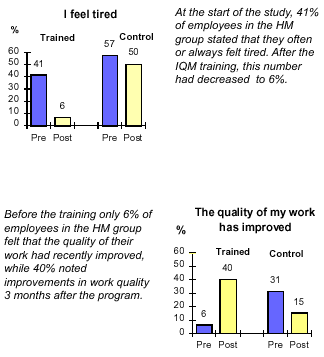Maximizing Performance While Reducing Risk
The new economy has ushered in an era of unprecedented change and transformation in our organisations--and the pace continues to accelerate. For some, this rapidly changing "new world" is challenging and stimulating; for many, it is extremely difficult. Recent scientific, medical and organisational research demonstrates that the turbulence of change and transformation and subsequent feelings of being overwhelmed, under-resourced, time-pressured and stressed substantially prevent individuals, teams and entire organisations from optimum performance.
Symptoms indicating that the pressure associated with change is taking its toll on a workforce cover a broad spectrum. Some of these symptoms, e.g., indigestion, body aches, feelings of negativity and resentment may appear relatively insignificant or even unrelated to workplace efforts. Yet an accumulation of these "minor" symptoms often leads to far more dangerous conditions threatening both the health of the individual and the performance of the organisation. Research has shown that a rise in the physical symptoms is a leading indicator of productivity losses.
High blood pressure, or hypertension, is one of the most prominent public health issues in the U.S. and Europe, affecting approximately one in four adults. High blood pressure is a major risk factor for death and disability, and has been strongly linked with decreases in cognitive performance, memory loss and deterioration of healthy brain tissue.
A number of recent studies show that stress is a significant, yet manageable, contributor to hypertension. Hypertension has been shown to contribute to absenteeism, disability, impaired performance and loss of productivity.
For the past ten years, HeartMath has been proving the link between the physical symptoms of stress and workplace effectiveness. As part of its program offerings, HeartMath delivers tools and techniques that individuals in organisations use to improve their business performance while effectively managing work/life balance. Organisations benefit from increased productivity, reduced health care costs, lower absenteeism and improved retention.
Purpose of the Study
This study was designed to determine whether training
in Inner Quality Management (IQM)® could reduce blood
pressure and simultaneously improve business performance
in known hypertensive individuals. Numerous studies
have demonstrated that the IQM techniques improve
cardiovascular health, hormonal balance and immune
function, as well as enhancing cognitive performance,
communication and job satisfaction.4
In particular, a number of pilot studies conducted at Motorola, Shell and BP have demonstrated that executives with Stage 1 and Stage 2 hypertension who participated in an IQM training program were able to restore their blood pressure to normal values without the aid of medication after practicing the IQM techniques.5
In the present study, the impact of the HeartMath Inner Quality Management Program was investigated in a group of hypertensive individuals, using a randomized controlled trial design. Psychological and performance-related parameters, as well as heart rate variability measures, were assessed concurrently with blood pressure changes to determine the overall impact of the program on employees' health, well-being and effectiveness.
Study Design
Thirty-eight hypertensive men and women from a Fortune
100 High Tech firm participated in the study. The
participants were randomized into a target group that
would first receive the training and a "waiting control"
group, that would receive the training 90 days after
the target group had been trained and data collected
from both groups. All participants' baseline BP was
measured once a week for four consecutive weeks and
psychometric data were also collected prior to training.
The Personal and organisational Quality Assessment-Revised
(POQA-R), a broad-based assessment of psychological
states and outcomes relating to business performance,
and the Brief Symptom Inventory (BSI), a clinically
valid measure of key indicators of psychological distress,
were used. The psychometric data, additional BP and
Heart Rate Variability (HRV) data was collected again
from both groups approximately 90 days after the target
group's final training session. The same training
was then delivered to the waiting control group.
The Program & Training Delivery
The IQM training was delivered in one full day (8-hour)
and two half-day (4-hour) sessions over three successive
weeks. In addition to the class room material, participants
were trained in the use of the emWave®,
HeartMath's award-winning heart monitor and learning
system, which assists in the management of emotional
and physiological responses and monitors Heart Rate
Variability patterns (heart rhythms) through a personal
computer.
Blood Pressure Outcomes
The reduction in systolic BP in the HeartMath (HM)
treatment group was significantly larger than that
in the waiting control (WC) group (p<.05). The
HM group demonstrated a mean adjusted reduction of
10.6 mm Hg in systolic BP; as compared with the WC
groups' mean adjusted reduction of 3.7 mm Hg. For
diastolic BP, the HM group showed a mean adjusted
reduction of 6.3 mm Hg, while the WC group demonstrated
a mean adjusted reduction of 3.9 mm Hg. The figure
below displays the systolic and diastolic BP changes
in both groups adjusted for baseline P, age, gender,
Body Mass Index and medication status.
The changes in systolic and diastolic pressure seen in the study are equivalent to:
- 40 pound weight loss
- Double the effect of sodium-restricted diet
- Double the effect of exercise program

Because of the BP reductions they were able to achieve using the techniques, three participants in the treatment group who were regularly taking antihypertensive medications were able to reduce their medication usage, with their physicians' approval, during the study period. Of these, one participant was permitted to discontinue medication usage entirely following completion of the study.
Psychological and Performance
Outcomes--POQA-R Results
The results of the POQA-R survey revealed numerous
significant improvements in key indicators of both
personal and organisational effectiveness in the HM
group as compared to the waiting control group.
HM group's results mostly improved while those of the control group declined over the same period of time. This suggests that the intervention not only stimulated positive changes but, potentially, may have also helped to reverse a trend toward decreased effectiveness in these measures.
Improvement in a number of areas was substantial, with clear implications for organisational productivity and quality.
Further improvements in the HeartMath group were measured in survey items dealing with areas that include communication, recognition, attitude toward the organisation, positive outlook and value of work contribution, among others. The group also demonstrated substantial reductions in items reflecting burnout and physical stress symptoms.
Conclusions & Recommendations
This study demonstrates that the HeartMath Inner Quality
Management program was effective in reducing blood
pressure in a group of hypertensive employees over
a 3-month period. Simultaneously, dramatic improvements
were shown in employee attitudes and business performance.
Not only are these employees healthier and less likely
to be away from work for reasons relating to high
blood pressure and its consequences, but they also
feel less like quitting, find themselves better recognised
for their efforts by the company, are communicating
better with each other while coping effectively with
the pressures of their jobs and their lives.
References
- Neurology,1998.Journal of American Medical Association, 1995.
- Journal of HypertensIon, 1998.AmerIcan Heart Journal, 1998.
- Journal of Occupational and Environmental Medicine,1999.
- American Journal of Cardiology,1995.Stress Medicine, 1997.
- Watkins, A. The personal and business benefits of the Inner Quality Management Programme: Case Study 9, Oil Company 1. Hunter Kane Ltd, Southampton, UK, 1999.
For Information
Telephone: (02) 9412 2500 (Australia)
Telephone: +61 2 9412 2500 (International)
E-Mail: info@macquarieinstitute.com.au
![]() Download our PDF
brochure
Download our PDF
brochure
